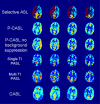Intra- and multicenter reproducibility of pulsed, continuous and pseudo-continuous arterial spin labeling methods for measuring cerebral perfusion
- PMID: 21304555
- PMCID: PMC3170937
- DOI: 10.1038/jcbfm.2011.10
Intra- and multicenter reproducibility of pulsed, continuous and pseudo-continuous arterial spin labeling methods for measuring cerebral perfusion
Abstract
Intra- and multicenter reproducibility of currently used arterial spin labeling (ASL) methods were assessed at three imaging centers in the Netherlands, equipped with Philips 3TMR scanners. Six healthy participants were scanned twice at each site. The imaging protocol consisted of continuous ASL (CASL), pseudo-continuous ASL (p-CASL) with and without background suppression, pulsed ASL (PASL) with single and multiple inversion times (TIs), and selective ASL for segmentation. Reproducibility was expressed in terms of the coefficient of repeatability and the repeatability index. Voxelwise analysis of variance was performed, yielding brain maps that reflected regional variability. Intra- and multicenter reproducibility were comparable for all methods, except for single TI PASL, with better intracenter reproducibility (F-test of equality of two variances, P<0.05). Pseudo-continuous ASL and multi TI PASL varied least between sites. Variability maps of all methods showed most variability near brain-feeding arteries within sessions and in gray matter between sessions. On the basis of the results of this study, one could consider the use of reference values in clinical routine, with whole-brain p-CASL perfusion varying <20% over repeated measurements within the same individuals considered to be normal. Knowledge on regional variability allows for the use of perfusion-weighted images in the assessment of local cerebral pathology.
Figures






Similar articles
-
Measurement of brain perfusion in newborns: pulsed arterial spin labeling (PASL) versus pseudo-continuous arterial spin labeling (pCASL).Neuroimage Clin. 2014 Aug 30;6:126-33. doi: 10.1016/j.nicl.2014.08.010. eCollection 2014. Neuroimage Clin. 2014. PMID: 25379424 Free PMC article.
-
[Influence of the Imaging Method on Regional Cerebral Blood Flow Value in Arterial Spin Labeling (ASL): Comparison of Pulsed-ASL with Two-dimensional Acquisition and Pseudo-continuous-ASL with 3D Spiral Acquisition].Nihon Hoshasen Gijutsu Gakkai Zasshi. 2022 Sep 20;78(9):969-977. doi: 10.6009/jjrt.2022-1265. Epub 2022 Aug 4. Nihon Hoshasen Gijutsu Gakkai Zasshi. 2022. PMID: 35922935 Japanese.
-
Pseudocontinuous arterial spin labeling perfusion magnetic resonance imaging--a normative study of reproducibility in the human brain.Neuroimage. 2011 Jun 1;56(3):1244-50. doi: 10.1016/j.neuroimage.2011.02.080. Epub 2011 Mar 6. Neuroimage. 2011. PMID: 21385620
-
Mapping of cerebral perfusion territories using territorial arterial spin labeling: techniques and clinical application.NMR Biomed. 2013 Aug;26(8):901-12. doi: 10.1002/nbm.2836. Epub 2012 Jul 15. NMR Biomed. 2013. PMID: 22807022 Review.
-
Clinical utility of arterial spin labeling imaging in disorders of the nervous system.Neurosurg Focus. 2019 Dec 1;47(6):E5. doi: 10.3171/2019.9.FOCUS19567. Neurosurg Focus. 2019. PMID: 31786550 Review.
Cited by
-
Visualization of incidentally imaged pituitary gland on three-dimensional arterial spin labeling of the brain.Br J Radiol. 2021 Jun 1;94(1122):20201311. doi: 10.1259/bjr.20201311. Epub 2021 Apr 29. Br J Radiol. 2021. PMID: 33914621 Free PMC article.
-
Pixel-by-Pixel Arterial Spin Labeling Blood Flow Pattern Variation Analysis for Discrimination of Rheumatoid Synovitis: A Pilot Study.Magn Reson Med Sci. 2017 Jan 10;16(1):78-83. doi: 10.2463/mrms.tn.2015-0145. Epub 2016 May 6. Magn Reson Med Sci. 2017. PMID: 27149946 Free PMC article.
-
Quantitative Functional Arterial Spin Labeling (fASL) MRI--Sensitivity and Reproducibility of Regional CBF Changes Using Pseudo-Continuous ASL Product Sequences.PLoS One. 2015 Jul 14;10(7):e0132929. doi: 10.1371/journal.pone.0132929. eCollection 2015. PLoS One. 2015. PMID: 26172381 Free PMC article.
-
Aerobic Exercise Training Improves Cerebral Blood Flow and Executive Function: A Randomized, Controlled Cross-Over Trial in Sedentary Older Men.Front Aging Neurosci. 2019 Dec 4;11:333. doi: 10.3389/fnagi.2019.00333. eCollection 2019. Front Aging Neurosci. 2019. PMID: 31866855 Free PMC article.
-
Altered cerebral perfusion in executive, affective, and motor networks during adolescent depression.J Am Acad Child Adolesc Psychiatry. 2013 Oct;52(10):1076-1091.e2. doi: 10.1016/j.jaac.2013.07.008. Epub 2013 Jul 25. J Am Acad Child Adolesc Psychiatry. 2013. PMID: 24074474 Free PMC article.
References
-
- Alsop DC, Detre JA. Multisection cerebral blood flow MR imaging with continuous arterial spin labeling. Radiology. 1998;208:410–416. - PubMed
-
- Anbeek P, Vincken KL, van Osch MJ, Bisschops RH, van der Grond J. Probabilistic segmentation of white matter lesions in MR imaging. Neuroimage. 2004;21:1037–1044. - PubMed
-
- Bland JM, Altman DG. Statistical methods for assessing agreement between two methods of clinical measurement. Int J Nurs Stud. 2010;47:931–936. - PubMed
-
- Buxton RB, Frank LR, Wong EC, Siewert B, Warach S, Edelman RR. A general kinetic model for quantitative perfusion imaging with arterial spin labeling. Magn Reson Med. 1998;40:383–396. - PubMed
MeSH terms
Substances
LinkOut - more resources
Full Text Sources

